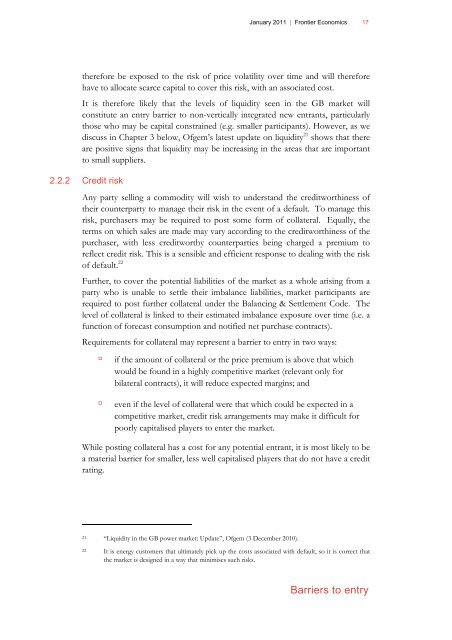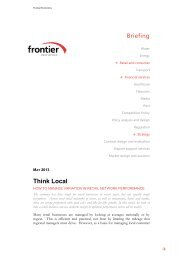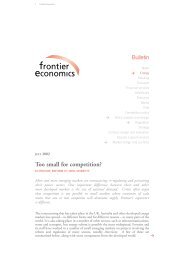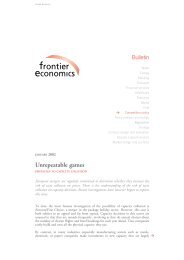competition and entry in the gb electricity retail market.pdf - Frontier ...
competition and entry in the gb electricity retail market.pdf - Frontier ...
competition and entry in the gb electricity retail market.pdf - Frontier ...
You also want an ePaper? Increase the reach of your titles
YUMPU automatically turns print PDFs into web optimized ePapers that Google loves.
January 2011 | <strong>Frontier</strong> Economics 17<br />
<strong>the</strong>refore be exposed to <strong>the</strong> risk of price volatility over time <strong>and</strong> will <strong>the</strong>refore<br />
have to allocate scarce capital to cover this risk, with an associated cost.<br />
It is <strong>the</strong>refore likely that <strong>the</strong> levels of liquidity seen <strong>in</strong> <strong>the</strong> GB <strong>market</strong> will<br />
constitute an <strong>entry</strong> barrier to non-vertically <strong>in</strong>tegrated new entrants, particularly<br />
those who may be capital constra<strong>in</strong>ed (e.g. smaller participants). However, as we<br />
discuss <strong>in</strong> Chapter 3 below, Ofgem’s latest update on liquidity 21 shows that <strong>the</strong>re<br />
are positive signs that liquidity may be <strong>in</strong>creas<strong>in</strong>g <strong>in</strong> <strong>the</strong> areas that are important<br />
to small suppliers.<br />
2.2.2 Credit risk<br />
Any party sell<strong>in</strong>g a commodity will wish to underst<strong>and</strong> <strong>the</strong> creditworth<strong>in</strong>ess of<br />
<strong>the</strong>ir counterparty to manage <strong>the</strong>ir risk <strong>in</strong> <strong>the</strong> event of a default. To manage this<br />
risk, purchasers may be required to post some form of collateral. Equally, <strong>the</strong><br />
terms on which sales are made may vary accord<strong>in</strong>g to <strong>the</strong> creditworth<strong>in</strong>ess of <strong>the</strong><br />
purchaser, with less creditworthy counterparties be<strong>in</strong>g charged a premium to<br />
reflect credit risk. This is a sensible <strong>and</strong> efficient response to deal<strong>in</strong>g with <strong>the</strong> risk<br />
of default. 22<br />
Fur<strong>the</strong>r, to cover <strong>the</strong> potential liabilities of <strong>the</strong> <strong>market</strong> as a whole aris<strong>in</strong>g from a<br />
party who is unable to settle <strong>the</strong>ir imbalance liabilities, <strong>market</strong> participants are<br />
required to post fur<strong>the</strong>r collateral under <strong>the</strong> Balanc<strong>in</strong>g & Settlement Code. The<br />
level of collateral is l<strong>in</strong>ked to <strong>the</strong>ir estimated imbalance exposure over time (i.e. a<br />
function of forecast consumption <strong>and</strong> notified net purchase contracts).<br />
Requirements for collateral may represent a barrier to <strong>entry</strong> <strong>in</strong> two ways:<br />
if <strong>the</strong> amount of collateral or <strong>the</strong> price premium is above that which<br />
would be found <strong>in</strong> a highly competitive <strong>market</strong> (relevant only for<br />
bilateral contracts), it will reduce expected marg<strong>in</strong>s; <strong>and</strong><br />
even if <strong>the</strong> level of collateral were that which could be expected <strong>in</strong> a<br />
competitive <strong>market</strong>, credit risk arrangements may make it difficult for<br />
poorly capitalised players to enter <strong>the</strong> <strong>market</strong>.<br />
While post<strong>in</strong>g collateral has a cost for any potential entrant, it is most likely to be<br />
a material barrier for smaller, less well capitalised players that do not have a credit<br />
rat<strong>in</strong>g.<br />
21 “Liquidity <strong>in</strong> <strong>the</strong> GB power <strong>market</strong>: Update”, Ofgem (3 December 2010).<br />
22 It is energy customers that ultimately pick up <strong>the</strong> costs associated with default, so it is correct that<br />
<strong>the</strong> <strong>market</strong> is designed <strong>in</strong> a way that m<strong>in</strong>imises such risks.<br />
Barriers to <strong>entry</strong>
















